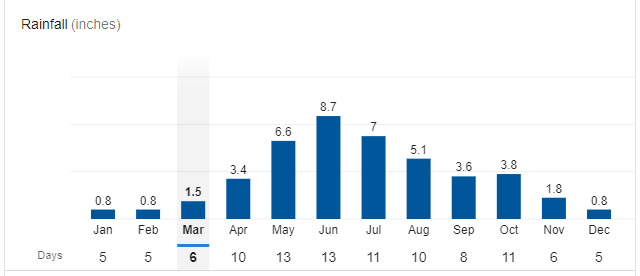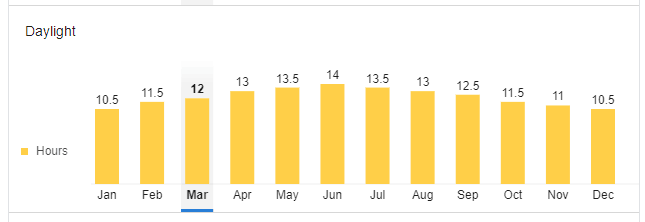
Guiyang Climate
Situated in the southwest of China, on the east side of Yunnan-Guizhou Plateau, due to its low latitude(106°27′E, 26°44′N) and high altitude (1100 meters), controlled by westerlies, Guiyang enjoys a subtropical humid monsoon climate, with about 15.3℃ of annual average temperate and 77% of annual mean relative-humidity. Neither intense heat in summer nor bitter cold in winter, Guiyang has pleasant climate with moist air, no wind or sand all year around. And pleasant weather in Guiyang makes it a cozy city for living.
Meanwhile, its hottest days occur in late July, with the top temperature of around 28℃, and the average temperature in the hottest month is about 24℃. The coldest days are in the early January, rarely going below 0℃. The temperature of the coldest month is about 4.6℃ on average.
Climate Data Graphs for Guiyang

Located at the altitude of about 1100 meters and controlled by westerlies, Guiyang belongs to the subtropical humid and temperate climate, with an annual average temperature of 15.3 ℃. Guiyang has no intense heat in summer, the average temperature in summer is 23.2℃, the highest temperature is 25-28℃ on average. The average temperature is only 23.7 ℃ in late July, the hottest time. In the whole year, the number of days with the temperature higher than 30℃ is less, only 35.8 days on average in the last five years, and the days above 35℃ is only 0.3 days. No bitter cold in winter, in Guiyang, the average temperature in the early January is 4.6℃.

The rainfall is abundant in summer, about 500 mm, and the precipitation at night accounts for 70% of the annual precipitation. The annual average total precipitation is 1129.5 mm. Besides, the annual average relative humidity is 77%, the annual lightning days are 49.1 days on average; The annual mean cloudy days are 235.1 days; The annual snowfall days are less, and the average is only 11.3 days.

The annual average sunshine hours in Guiyang are 1148.3 hours or so. The ultraviolet intensity is weak or very weak, except a quite short period of time at noon.
Tips for Guiyang Weather
Four Seasons of Guiyang
Guiyang enjoys a subtropical humid and temperate climate, with the average temperature of about 15.3℃. In spring, Guiyang takes on a new look with refreshing feeling and pleasant climate. Guiyang is a good choice for spring outing. In summer, without intense heat, the average temperature is about 23.2℃. And even if in the hottest late July, the mean temperature is no more than 25℃. Guiyang is good place to escape the heat. In autumn, with clear and refreshing autumn weather, you can have a panoramic view of the beautiful Guiyang. In winter, without severe cold, in the coldest early January, the average temperature is above 0℃.
Best Time to Visit
The best time to travel in Guiyang is in spring, summer and autumn, in particular, in the late August. In March and April, you can experience many traditional festivals of Miao minority. From April 30 to May 7, there is the Baiyun National Kites Festival. From June to August is the Hongfeng(red maple) lake tourism festival, lasting nearly 2 months. The best time for visiting the Huangguoshu Waterfalls near Guiyang is summer and autumn. A pleasant weather means that tourists can visit at any time of the year.
Packing Tips
The mild weather throughout the year makes Guiyang popular among travelers. However, due to abundant rainfall in Guiyang, it is best to bring rain gears with you when going on a tour. Folding umbrella is essential. In addition, the ultraviolet intensity is weak in Guiyang, except a quite short period of time at noon. So sunscreen products like sun scream and hat are needed, especially at noon. The temperature in Guiyang is lower in the morning and evening, so it is necessary to bring a windproof coat. In winter, you should wear sweater and thick coat because of the wet and cold weather.
Peak Seasons
Try to avoid the Chinese peak holidays when planning your Guiayng tour. Popular with Chinese travelers, scenic spots in Guiyang become much more crowded during peak holidays. The most crowded holidays are Spring Festival(usually in late Jan. or early Feb.), International Labor Day(May 1-3) and National Day(Golden week, Oct. 1-7).
Keep Reading












